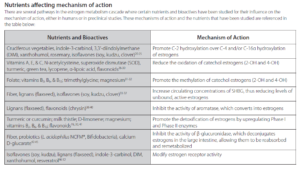Estrogen affects the growth, differentiation, and function of numerous tissues throughout the female body—not just those involved in reproduction. This hormone plays an important role in bone health, protects the cardiovascular system, and influences behavior and mood. While appropriate levels of estrogens are essential for good health, several studies conclude that as inappropriate exposure to estrogen increases, the risk of several cancers—including breast, ovary, prostate, and thyroid—also increases.1-7 Furthermore, disproportionate estrogen exposure can lead to other health problems, including polycystic ovarian syndrome (PCOS), premenstrual syndrome (PMS), endometriosis, and fibrocystic breast tenderness or mastalgia.8
Various lifestyle and environmental factors can influence estrogen production, metabolism, and balance. These include poor diet, obesity, excess alcohol consumption, high insulin levels, medications such as hormone replacement therapy and birth control pills, overexposure to chemicals found in pesticides and industrial chemicals, and agricultural hormones in animal products consumed by humans.9-12 Genetics can also play an important role in determining estrogen levels.13
| Download the PDF |
Estrogen metabolism and nutritional influences
Estrogen is the primary hormone responsible for sexual and reproductive development in women. Once puberty begins, the body uses estrogen to regulate the first half of the menstrual cycle and then metabolizes the hormone for elimination via urination and defecation. Dietary and lifestyle modifications that support a healthy weight, like consuming a nutrient-dense dietary pattern (e.g., increasing intake of fiber and phytoestrogens) and being physically active, have been linked to the modulation of estrogen metabolism. In addition, many nutrients and nutritional bioactives have been studied for their influence on pathways of estrogen metabolism and detoxification, including but not limited to isoflavones, indole-3-carbinol, B vitamins, magnesium, limonene, calcium D-glucarate, and antioxidants.
Mechanism of action
“Estrogen” is a term that is used to collectively describe the female hormones estradiol, estrone, and estriol. The most potent of these is estradiol. Estrogens circulate in the body mainly bound to the sex hormonebinding globulin (SHBG), and only unbound estrogens can enter cells and cause biological effects.14-15 Therefore, any change in the concentration of SHBG will alter estrogen activity by changing the availability of estrogen to the target cell.
The ultimate biologic effect of estrogen depends on how it is metabolized. The metabolism of estrogen takes place primarily in the liver through Phase I (hydroxylation) and Phase II (methylation and glucuronidation) pathways, which allow estrogen to be detoxified and excreted from the body. Hydroxylation yields three estrogen metabolites that vary greatly in biological activity: 2-hydroxyestrone (2-OH), 16-hydroxyestrone (16α-OH), and 4-hydroxyestrone (4-OH).14 The 2-OH metabolite is generally termed the “good” estrogen because it generates very weak—and therefore potentially less harmful—estrogenic activity in the body. In contrast, the 16α-OH and 4-OH metabolites show persistent estrogenic activity and may promote dangerous tissue growth if unchecked.16 In fact, women who metabolize a larger proportion of their estrogen via the 16α-OH metabolite may be at significantly higher risk of developing breast cancer.17
The 2-OH and 4-OH estrogen metabolites are further detoxified via a process called methylation. This is an important pathway, because it renders the harmful 4-OH metabolite significantly less active and also activates the protective 2-OH into the beneficial (and more active) 2-methoxyestrone (2-MeOE1 & 2). Furthermore, if the 2-OH and 4-OH estrogens are not methylated, they can be converted to highly reactive molecules that could potentially damage DNA.16-18 Glucuronidation is one of the key Phase II liver detoxification pathways for estrogen, facilitating its elimination from the body.19
Nutrients affecting mechanism of action
There are several pathways in the estrogen metabolism cascade where certain nutrients and bioactives have been studied for their influence on the mechanism of action, either in humans or in preclinical studies. These mechanisms of action and the nutrients that have been studied are referenced in the table below:



